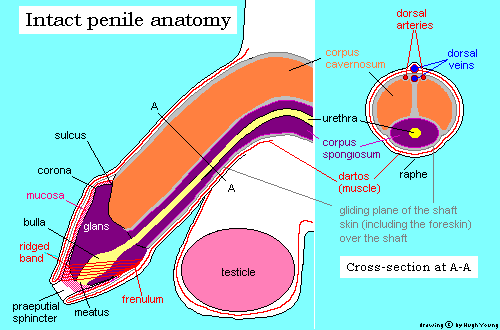|
|
|
Functions of the foreskin This diagram of the intact or uncircumcised penis will help you to understand the list of functions described on this page: The following is a list of the most well-known functions of the natural (intact) foreskin. With circumcision, it's obvious that these functions are lost, in whole or part. Depending on the degree of circumcision, the process of foreskin restoration can help to provide some of these functions. As you will observe, the foreskin is not just a redundant piece of skin but a specialized part of a unique and essential organ. Wanting some of these functions back may be a factor in encouraging men to restore their foreskin.
Protection If it were possible to measure the surface area of the average foreskin by folding it out flat, you might be surprised to find it covers an area of over fourteen square inches. This is extremely specialized tissue and serves to protect the glans from callusing (keratinization), abrasion, drying, and damage of all kinds. Sensitivity Discovered as late as 1996, the so-called ridged band of the inner foreskin is comprised of a half-inch wide section of accordion-like corrugated skin which is one of the most intensely innervated erogenous areas on the male body. This area of skin may have a role in triggering the male orgasm and it's loss has a detrimental impact on the range and intensity of a man's sexual pleasure. It may even be that loss of the foreskin has some relationship with with the occurence of anorgasmia or retarded ejaculation in men who cannot ejaculate during sexual intercourse. Pleasure The foreskin has a pronounced "gliding action" which makes movement of the penis in the vagina easy and facilitates both masturbation and vaginal thrusting. The foreskin acts as a seal during intercourse: without it, the corona of the surgically circumcised penis operates like a one-way valve, and has the unfortunate effect of removing vaginal juices and lubricants - thereby making artificial lubricants a necessary addition for achieving pleasurable intercourse. Specialized erogenous nerve receptors The foreskin is the location of thousands of fine-touch-sensitive nerve cells. There are between 10,000 and 20,000 specialized pleasure-producing nerve endings in the foreskin, and they can detect even minimal changes in movement, texture, pressure, stretch, and temperature. Circumcision removes them all. The frenulum The frenulum, a highly sensitive and erogenous structure on the underside of the glans, often used by men during masturbation to promote orgasm and ejaculation, is often cut off during circumcision or severed. The intense pleasure which it produces is lost, although the so-called “sweet spot” on the bottom side of the glans of circumcised men may be what is left of the frenulum after circumcision. Temperature-responsive tissue The foreskin has many temperature-responsive receptors, which may play a part in maintaining the scrotum at the ideal temperature for sperm production. Immunological secretions The smooth mucosa of the inner foreskin produces both plasma cells that secrete immunoglobulin antibodies, and antibacterial and antiviral proteins such as the pathogen-killing enzyme lysozyme. Lymphatic vessels The foreskin contains lymph vessels; lymph flow enhances the operation of the body's natural immune system, and may also affect immunological secretions. Estrogen receptors The foreskin contains estrogen receptors. Their biological/sexual purpose of these is not understood. Apocrine glands The apocrine glands of the inner foreskin secrete pheromones, chemical molecules which function as nature's invisible yet powerful signals to potential sexual partners. We know their effects on human sexuality can be profound. Immune-protective cells The specialized epithelial cells of the foreskin are the primary element in the body's natural immune system in a whole penis The development of a normal glans and inner foreskin The tissue layer which protectively fuses the natural foreskin and glans together during the period while a young boy's penis is developing prior to puberty, is torn in two during circumcision, damaging the glans and any remaining foreskin, leaving the tissue raw and open to infection, scarring, shrinkage, discoloration and pitting. The natural color of the undamaged (uncircumcised) glans, is a healthy pink, red or dark purple. Unobstructed full penile extension The foreskin allows full extension of the penile tissue during erection, and provides the opportunity for the penis to grow to its natural maximum length and circumference. This extension can take place because the loose and usually overhanging foreskin is very extensible and flexible. Loss of approximately half of the skin on the penis tends to make the penile skin on the shaft very tight during an erection, so the penis is pulled in towards the body. Most men who have restored their foreskin will report an increase in length and girth. Natural full penile blood flow The loss of the rich vascularity of penile blood vessels, including the frenular artery and branches of the dorsal artery, interrupts normal blood flow to the shaft and glans of the penis, altering development of the penis and damaging its natural function. This list, slightly modified, is thanks to Gary L. Harryman, 2004 |
